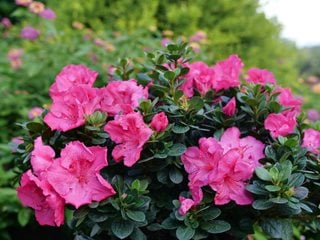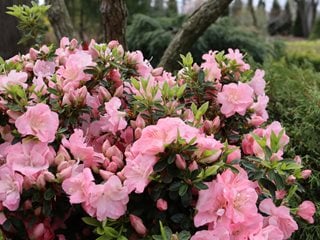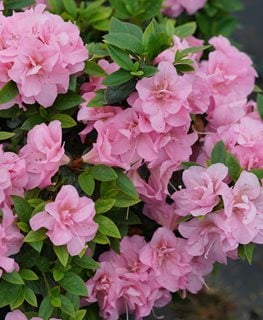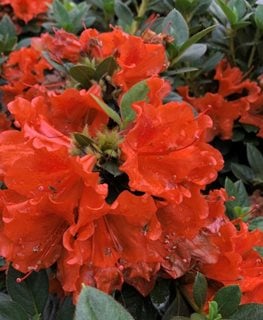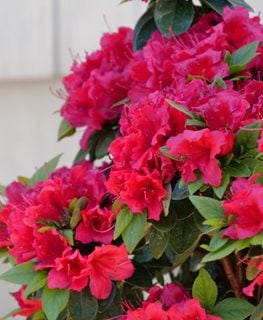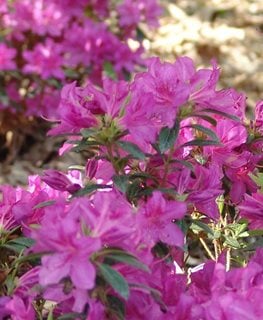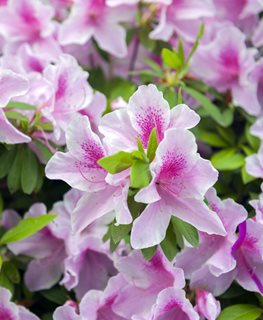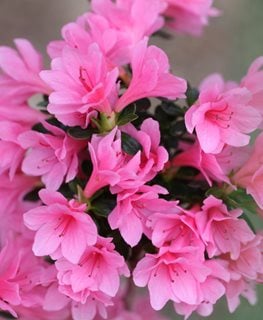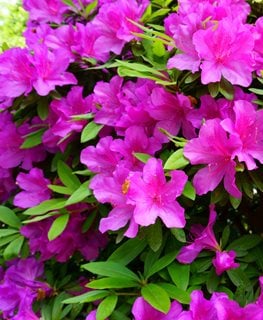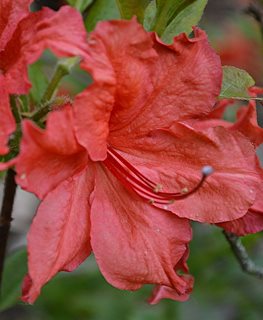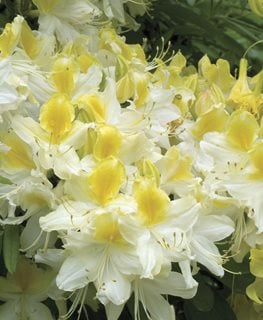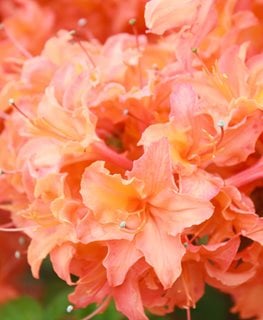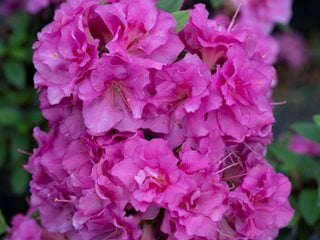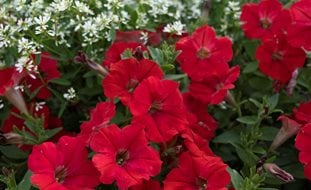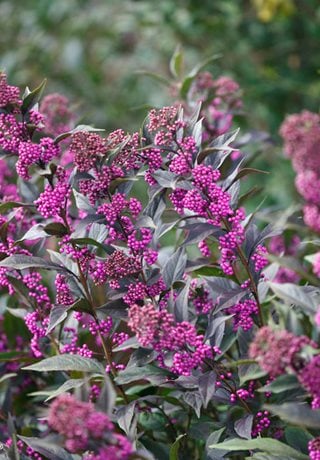Azalea Bushes: Growing & Care Tips
Learn how to plant, prune, and care for azalea plantsAzaleas are one of the most popular flowering shrubs, with hundreds of varieties that come in a range of forms and sizes. A type of Rhododendron, azaleas bloom primarily in spring, though some cultivars rebloom later in the growing season. Most are evergreen, originating in Asia, while those native to North America are deciduous.
Grown for the attractive flat, single or double funnel-shaped flowers that come in a wide array of colors and patterns, azalea bushes are also a valuable background plant in woodland settings and borders. This versatile shrub can be used as hedging, screening, or in foundation plantings. Smaller specimens are suitable for containers. Here’s how to grow and use azaleas in your landscape.
On this page: Basics | Planting | Care | Varieties | Design Ideas | FAQ's
On this page:
- BASICS
- PLANTING AZALEAS
- AZALEA CARE & MAINTENANCE
- AZALEA VARIETIES
- DESIGN IDEAS
- FREQUENTLY ASKED QUESTIONS
BASICS
Botanical name:
Rhododendron spp. and hybrids
Zones:
Most are hardy in Zones 6-9; with some deciduous varieties hardy down to Zones 3-5.
Habit:
Upright, bushy, open, spreading or groundcover habit
Height/Spread:
Average size is 4 to 6 feet tall and wide; with varieties ranging from 1 to 20 feet tall and 2 to 20 feet wide.
Exposure:
Full sun to partial shade. Protect from hot afternoon sun. Plants can tolerate more sun in northern climates, while too much shade will result in fewer blooms.
Soil:
Azaleas prefer rich acidic soil with a pH between 4.5 and 6.0. Good drainage is essential to prevent root rot or other diseases. “Do NOT use lime unless the soil pH is below 3.0,” warns the Azalea Society. A soil test—such as those offered through local Cooperative Extensions—is the best way to determine pH and nutrient deficiencies.
When do azaleas bloom?
Early spring into summer, with some varieties that rebloom from summer into fall.
Flowers:
Funnel-shaped single or double flowers come in a wide range of colors, some with speckled patterns or fragrance.
Foliage:
On evergreen plants, leaves are thin, with small hairs, some with purplish winter color. On deciduous plants, leaves are elongated and emerge around the same time as blooms, or shortly after; some varieties have excellent fall color.
PLANTING AZALEA BUSHES
When to plant:
Plant azalea shrubs during the cooler months of spring or fall to avoid heat or cold stress.
Where to plant:
Choose a full to partially sunny site with rich well-draining soil. "Always plant azaleas and rhododendrons where they get wind protection. Plants not given protection from the wind often develop leaf scorch or splitting of the bark on the stems." — University of Missouri Extension.
How to plant:
Loosen soil in planting area and amend with compost or other organic matter. Dig a planting hole slightly wider and deeper than the root ball. Make several slits in the root ball. Place the plant in the hole with the top of the root ball slightly above the surrounding ground to allow for settling, and fill in around the sides of the root ball. Do not cover the top of the root ball with soil. Cover the root ball with soil and tamp down. Water thoroughly and keep soil evenly moist until established.
Spacing:
Allow enough space around plants to accommodate their mature size.
For containers:
Make sure pots have adequate drainage holes. Use a high quality all-purpose potting mix.
AZALEA CARE
"One really important thing to remember about azaleas is that they have very shallow roots. This makes them more sensitive to water stress because they don't have those deeper roots that go down and search for water. Watch for wilting, curling leaves, or brown foliage as a signal they're not getting enough water." — Stacy Ling
Watering:
Azaleas have shallow roots, so are more sensitive to water stress. Keep soil evenly moist but not soggy. Overwatering can cause root rot or other diseases. Increase watering during hot or dry spells to prevent wilting, leaf curl, or brown foliage. Containers dry out more quickly, so will need more frequent watering.
Amendments and fertilizer:
In spring, apply a fertilizer especially formulated for acid-loving plants, such as azaleas, camellias, and rhododendrons, according to package instructions.
Mulch:
Add several inches of organic material around the base, but not up to them stem, to suppress weeds, retain moisture for the shallow roots, and provide additional nutrients. Replenish mulch annually. (See more tips on mulching.)
Pruning:
Azaleas look best when they are allowed to keep their natural shape and size. Prune azaleas just after flowering. Cut back errant branches and shape as needed. This is also the time to shear formal hedges. Cutting back plants in summer or fall will result in the loss of the next year’s flower buds. Remove dead or diseased growth as soon as it appears.
Diseases & pests:
Azaleas are prone to a number of pests and diseases, though healthy plants are more resistant. Pests include aphids, spider mites, scale, whitefly, borer, thrips, nematodes, weevils, and lace bugs. Diseases include powdery mildew, rust, leaf spot, crown or root rot, petal blight, leaf gall, chlorosis, canker, and dieback.
AZALEA VARIETIES
Azalea alternatives:
Substitute other shrubs with similar cultural needs such as rhododendron, mountain laurel (Kalmia), hydrangea, viburnum, beautyberry, or summersweet (Clethra).
DESIGN IDEAS
For borders and landscapes: Use as hedging or screening, in foundation plantings, mixed or woodland borders.
For slopes and hills: Mass along a slope or hillside for erosion control.
For containers: Smaller specimens can be planted in containers by themselves or in combination with other plants for multi-seasonal interest.
Here are a few tips for incorporating azaleas into your garden:
- Use a medium-sized variety as formal clipped hedging along a street, sidewalk, or fence or to divide garden rooms.
- Combine with a mix of other deciduous and evergreen shrubs for a four-season foundation planting.
- Plant alongside other flowering shrubs that bloom at different times for a continuous display of color.
- Underplant with spring blooming bulbs such as crocus, daffodil, and muscari for an early season color display.
- A larger evergreen variety can be massed along a property line for year-round privacy.
Companion plants: Azalea companion plants include abelia, dogwood, ferns, hosta, sedges, Japanese andromeda (Pieris), witch hazel, hellebores, and snowdrops.
FREQUENTLY ASKED QUESTIONS
What is the difference between an azalea and a rhododendron?
Azaleas and rhododendrons are both classified in the genus Rhododendron, though are differentiated by several characteristics. Azaleas are generally smaller and may be deciduous or evergreen, while rhododendrons are strictly evergreen. Leaves of azaleas are thinner, often with a soft, hairy texture. An azalea flower typically has 5 to 6 stamens, while a rhododendron bloom usually has 10 or more stamens. Azaleas produce 1 to 3 flowers per stem, while rhododendron blooms occur in larger clusters.
Are azaleas poisonous?
Azaleas contain grayanotoxins, which can be extremely harmful to pets and livestock. Ingesting even a few leaves can cause serious injury. If you suspect your pet has ingested any part of the plant, take them to an emergency veterinarian immediately. Make sure to take a sample of the plant along for positive ID. Plants can also be harmful to small children; go to an ER immediately if your child ingests any part of the plant.
Are azaleas deer resistant?
Deer find the leaves and stems of azaleas to be appealing and can cause significant grazing damage to plants.
Why aren't my azaleas blooming?
There are a number of factors that can keep azaleas from blooming:
- Pruning at the wrong time. Azaleas bloom on old wood. If they are pruned too late in the season, next year's buds can be sacrificed.
- Using the wrong fertilizer. A fertilizer that is too high in nitrogen will put the plant's energy into producing foliage, not flowers.
- Cold weather. Harsh winter weather can cause damage to azalea branches where the buds are held.
- Not enough sunlight or water. Make sure your azalea is getting at least 6 hours of sunlight each day and is watered regularly.
ABOUT THE AUTHOR
Janet Loughrey is a veteran garden writer and photographer with over 25 years of experience, contributing to major publications like Garden Design, Better Homes and Gardens, and Sunset. A former Master Gardener, she brings hands-on expertise from gardening in a wide range of climates, from upstate New York to the Pacific Northwest.
